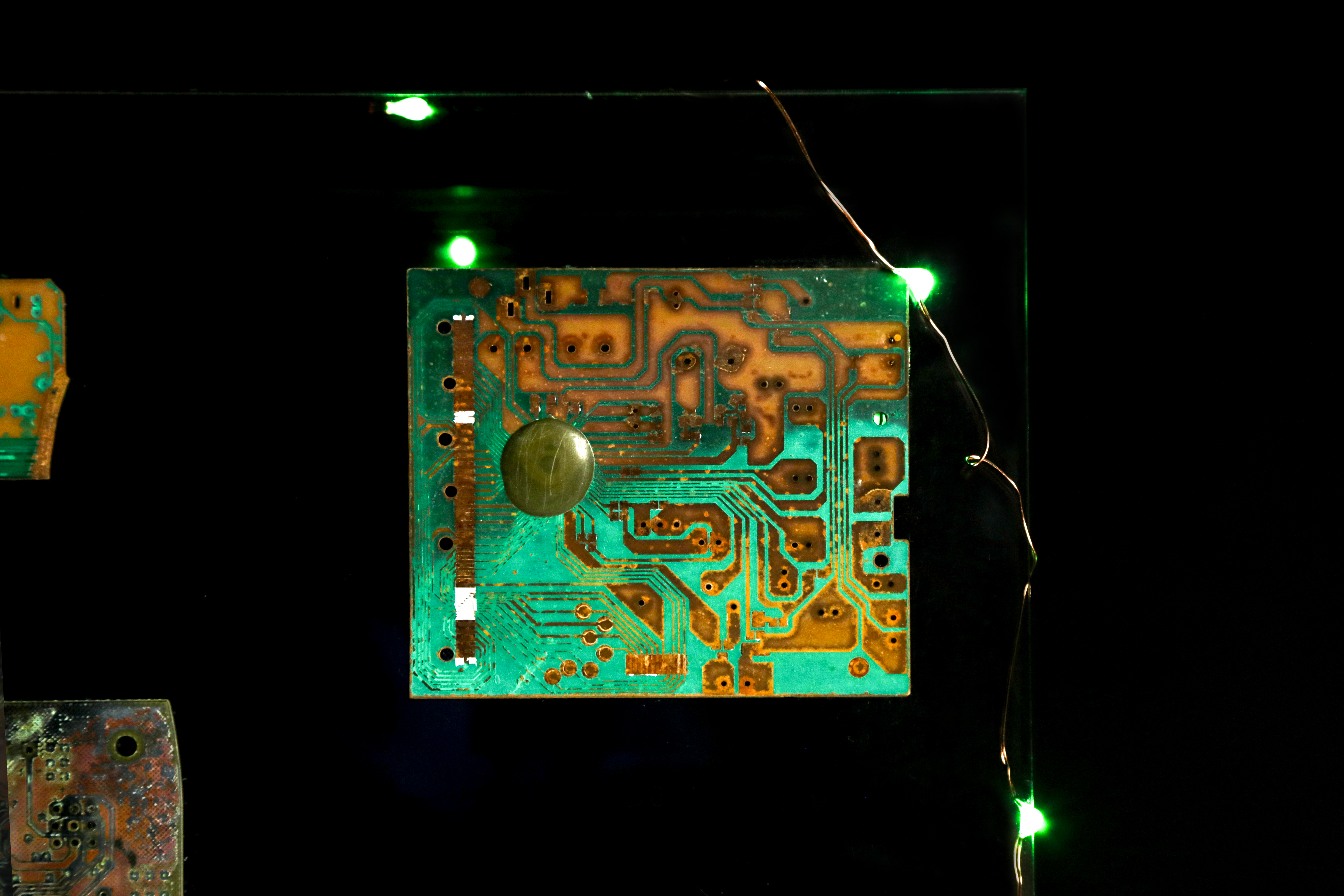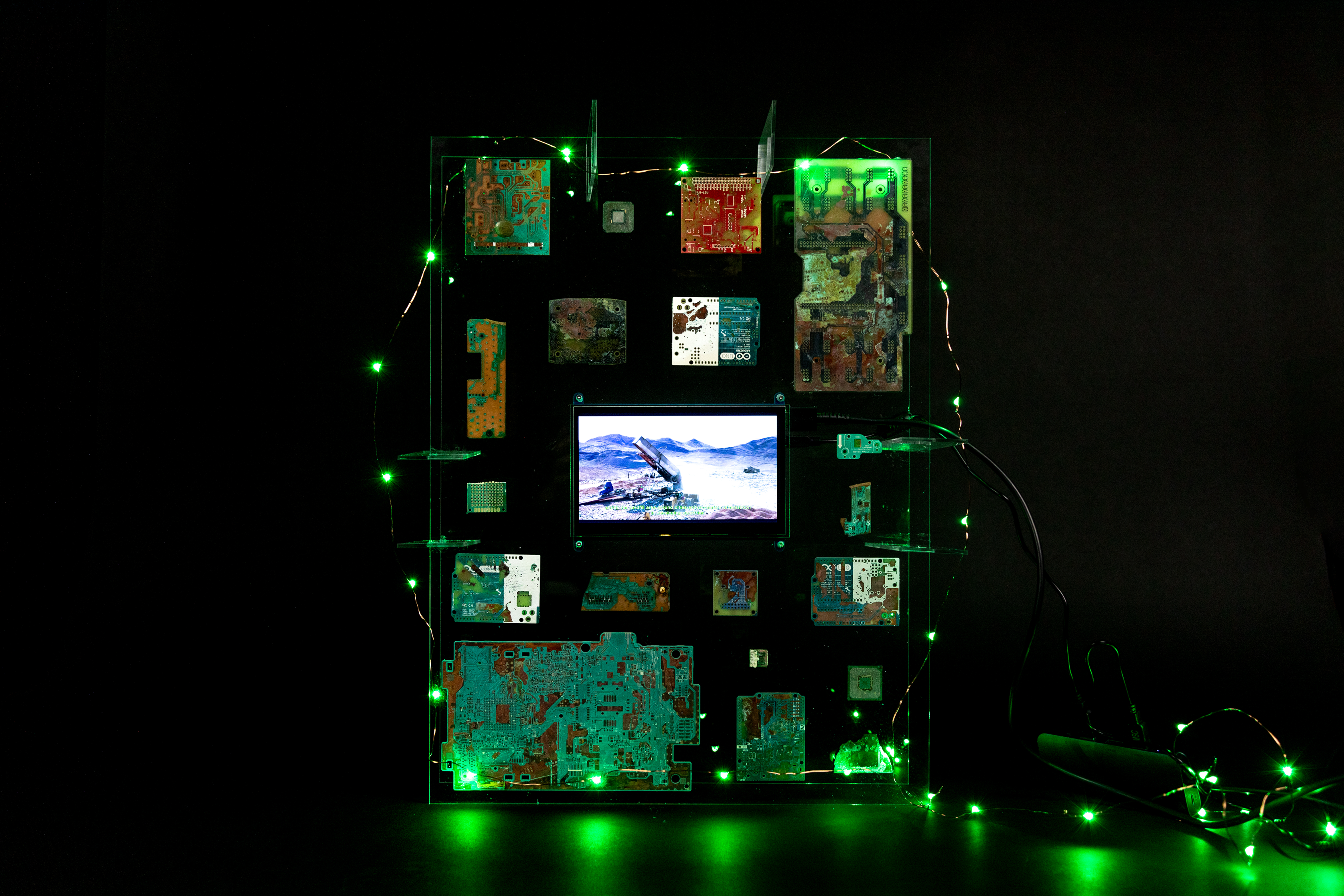ELECTION: URBAN MINING
2023
选举:城市矿业
在2050年,电子垃圾的趋势正在上升,其隐藏的价值正在迅速被利用。靠绿色政策竞选的政党将电子垃圾回收视为促进公众热情和可持续发展愿景的一种方式,从而在选举中为其政党赢得更多选票。聪明的科技回收公司和组织认识到电子废物背后的巨大利益,这是一座充满金子的城市矿山,但问题是:应该在哪个地区开采?谁来为这座矿山提供土地和人力资源?
随着回收工厂在不同的低收入国家的城市边缘涌现,这些边缘成为电子荒地,为少数人的利益服务。那些没有从城市化中受益的人继续在城市边缘徘徊。城市化的地图变化就像电子垃圾被腐蚀的过程,城市化也是绿色树林被腐蚀的象征。随着时间的推移,电子垃圾处理留下的化学物质渗入当地的土地和水,伤害了脆弱的群体,他们可能知道自己是无辜的,但没有人为他们负责。
绿党政策的本质不是环境保护,而是后殖民时代的矛盾转移,也是前殖民地在城市化和污染方面承担发达国家代价的表现。被腐蚀的电子垃圾不仅显示了金属的处理和提炼所造成的化学腐蚀和二次环境污染,而且还映射出污染的转移和资本主义对欠发达地区的侵占。
该装置由透明的丙烯酸板构成,盐酸被用来腐蚀废弃的电路板(电子垃圾)上的油漆和镀层。经过处理的电路板被包裹在一个屏幕上,该屏幕连续播放绿色政党选举新闻和来自低收入地区的电子垃圾废墟。绿色的LED灯被包裹在亚克力板上,代表来自绿色政策的投票。
With: Lokyin Pang, Hanqi Li, Chuan Liu
在2050年,电子垃圾的趋势正在上升,其隐藏的价值正在迅速被利用。靠绿色政策竞选的政党将电子垃圾回收视为促进公众热情和可持续发展愿景的一种方式,从而在选举中为其政党赢得更多选票。聪明的科技回收公司和组织认识到电子废物背后的巨大利益,这是一座充满金子的城市矿山,但问题是:应该在哪个地区开采?谁来为这座矿山提供土地和人力资源?
随着回收工厂在不同的低收入国家的城市边缘涌现,这些边缘成为电子荒地,为少数人的利益服务。那些没有从城市化中受益的人继续在城市边缘徘徊。城市化的地图变化就像电子垃圾被腐蚀的过程,城市化也是绿色树林被腐蚀的象征。随着时间的推移,电子垃圾处理留下的化学物质渗入当地的土地和水,伤害了脆弱的群体,他们可能知道自己是无辜的,但没有人为他们负责。
绿党政策的本质不是环境保护,而是后殖民时代的矛盾转移,也是前殖民地在城市化和污染方面承担发达国家代价的表现。被腐蚀的电子垃圾不仅显示了金属的处理和提炼所造成的化学腐蚀和二次环境污染,而且还映射出污染的转移和资本主义对欠发达地区的侵占。
该装置由透明的丙烯酸板构成,盐酸被用来腐蚀废弃的电路板(电子垃圾)上的油漆和镀层。经过处理的电路板被包裹在一个屏幕上,该屏幕连续播放绿色政党选举新闻和来自低收入地区的电子垃圾废墟。绿色的LED灯被包裹在亚克力板上,代表来自绿色政策的投票。
With: Lokyin Pang, Hanqi Li, Chuan Liu
Election: Urban Mining
In 2050, the trend of e-waste is on the rise, and its hidden value is quickly being leveraged. Political parties running on green policies see e-waste recycling as a way to promote public enthusiasm and a vision for sustainability, thus gaining more votes for their party in elections. Smart tech recycling companies and organizations recognize the huge benefits behind e-waste, an urban mine full of gold, but the question remains: in which area should it be extracted? Who will provide the land and human resources for this mine?
As recycling factories pop up on the edges of cities in different low-income countries, those edges become electronic wastelands that serve the interests of a select few. Those who do not benefit from urbanization continue to wander on the edge of cities. Over time, chemicals left behind by e-waste disposal leach into the local land and water, hurting a vulnerable group of people who may be aware of their innocence but no one pay for them.
The essence of the Greens' policy is not environmental protection, but rather a post- colonial transfer of contradictions, as well as a manifestation of the former colonies bearing the costs of the developed world in terms of urbanization and pollution. Corroded e-waste not only shows the chemical corrosion and secondary environmental pollution caused by the disposal and refining of metals, but also maps the transfer of pollution and the encroachment of capitalism on less developed regions.
The installation is framed by transparent acrylic panels, and hydrochloric acid is used to etch paint and plating from discarded circuit boards (e-waste). The treated boards are wrapped around a screen that continuously broadcasts green party election news and the e-waste ruins from low-income areas. Green LED lights are wrapped around the acrylic panels to represent the votes from the green policy.
With: Lokyin Pang, Hanqi Li, Chuan Liu
In 2050, the trend of e-waste is on the rise, and its hidden value is quickly being leveraged. Political parties running on green policies see e-waste recycling as a way to promote public enthusiasm and a vision for sustainability, thus gaining more votes for their party in elections. Smart tech recycling companies and organizations recognize the huge benefits behind e-waste, an urban mine full of gold, but the question remains: in which area should it be extracted? Who will provide the land and human resources for this mine?
As recycling factories pop up on the edges of cities in different low-income countries, those edges become electronic wastelands that serve the interests of a select few. Those who do not benefit from urbanization continue to wander on the edge of cities. Over time, chemicals left behind by e-waste disposal leach into the local land and water, hurting a vulnerable group of people who may be aware of their innocence but no one pay for them.
The essence of the Greens' policy is not environmental protection, but rather a post- colonial transfer of contradictions, as well as a manifestation of the former colonies bearing the costs of the developed world in terms of urbanization and pollution. Corroded e-waste not only shows the chemical corrosion and secondary environmental pollution caused by the disposal and refining of metals, but also maps the transfer of pollution and the encroachment of capitalism on less developed regions.
The installation is framed by transparent acrylic panels, and hydrochloric acid is used to etch paint and plating from discarded circuit boards (e-waste). The treated boards are wrapped around a screen that continuously broadcasts green party election news and the e-waste ruins from low-income areas. Green LED lights are wrapped around the acrylic panels to represent the votes from the green policy.
With: Lokyin Pang, Hanqi Li, Chuan Liu



















